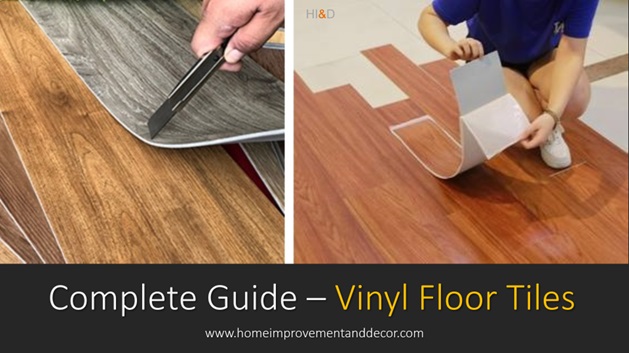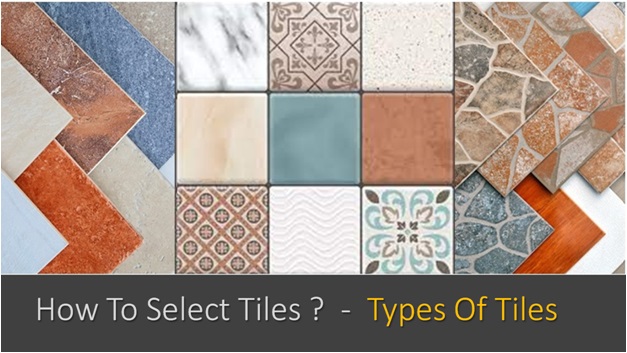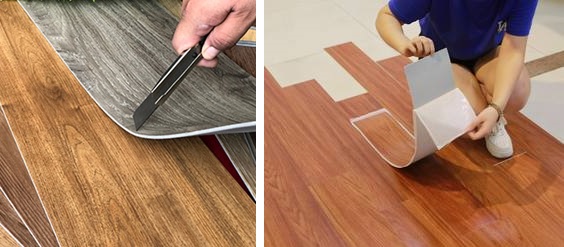
Vinyl Floor Tiles
Complete Guide To Vinyl Floor Tiles Or PVC Tiles - Designs , Technical Features And Installation.
Vinyl floor tiles, also known as PVC tiles, are a versatile and popular flooring option that offers elegant, cost effective and durable flooring option. Also referred as PVC tiles, it offers numerous benefits for residential and commercial spaces.
Made from a synthetic material called polyvinyl chloride (PVC), vinyl floor tiles are designed to replicate the look of various flooring materials, including wood, stone, and ceramic tiles.
PVC floor tiles, also known as vinyl floor tiles, are a type of resilient flooring that is commonly used in residential and commercial spaces. They are made from polyvinyl chloride (PVC), a synthetic material that is known for its durability, water resistance, and easy maintenance.
Rapid installation is another major advantage and the vinyl tiles can be installed in just few hours without any hassle. Floor can be immediately used after its installation.
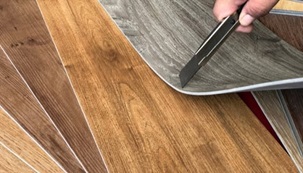
PVC floor tiles are highly durable and can withstand heavy foot traffic, making them suitable for areas with high usage, such as homes, offices, retail stores, and healthcare facilities.
PVC tiles are waterproof, which means they can be installed in areas prone to moisture, such as kitchens, bathrooms, and basements, without worrying about water damage. However, excessive exposure to wet conditions can cause the problem of peeling off and PVC tiles can get detached from the floor.
Vinyl floor tiles are composed of multiple layers of PVC. The topmost layer is the wear layer, which provides durability and resistance to scratches and stains. Beneath the wear layer is the printed or decorative layer, which features the design or pattern that mimics the appearance of natural materials. The core layer provides stability and additional strength to the tiles. The bottom layer is the backing layer, which helps with adhesion and stability when installing the tiles.
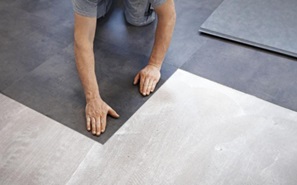
PVC floor tiles are highly durable and can withstand heavy foot traffic, making them suitable for areas with high usage, such as homes, offices, retail stores, and healthcare facilities.
PVC tiles are waterproof, which means they can be installed in areas prone to moisture, such as kitchens, bathrooms, and basements, without worrying about water damage. However, excessive exposure to wet conditions can cause the problem of peeling off and PVC tiles can get detached from the floor.
Vinyl floor tiles are composed of multiple layers of PVC. The topmost layer is the wear layer, which provides durability and resistance to scratches and stains. Beneath the wear layer is the printed or decorative layer, which features the design or pattern that mimics the appearance of natural materials. The core layer provides stability and additional strength to the tiles. The bottom layer is the backing layer, which helps with adhesion and stability when installing the tiles.
Types Of Tiles - Vinyl Floor Tiles
Types Of Vinyl Floor Tiles
Vinyl floor tiles come in various types, each offering its own advantages and characteristics. Here are some common types of vinyl floor tiles:
1. Luxury Vinyl Tiles (LVT)
Luxury Vinyl Tiles (LVT) is a high-quality vinyl flooring option that mimics the look of natural materials like wood, stone, or ceramic tiles. It often features realistic textures and patterns. LVT is durable, water-resistant, and easy to maintain.
2. Vinyl Composition Tiles (VCT)
Vinyl Composition Tiles (VCT): VCT is a type of vinyl tile that is commonly used in commercial settings. It consists of a mixture of vinyl resins, fillers, and pigments. VCT is known for its durability and affordability, and it requires regular maintenance, including polishing and waxing.
3. Peel-and-Stick Vinyl Tiles
Peel-and-Stick Vinyl tiles are self-adhesive vinyl tiles designed for easy installation. They come with a pre-applied adhesive backing, allowing them to be easily stuck onto a clean, smooth surface. Peel-and-stick tiles are often used in DIY projects and are available in a wide range of styles and designs.
4. Vinyl Plank Tiles
Vinyl plank tiles, also known as luxury vinyl planks (LVP), resemble hardwood flooring planks. They offer the appearance of natural wood with the durability and moisture resistance of vinyl. Vinyl plank tiles are available in various sizes, colors, and textures to mimic different wood species.
5. Vinyl Sheet Tiles:
Vinyl sheet tile flooring comes in large rolls and can be cut into tiles of different sizes and shapes. It provides a huge flexibility for its installation. Vinyl flooring in sheet form is generally priced much cheaper as compared to other PVC tiles.
How To Install Vinyl Floor Tiles ?
Installing vinyl tiles is a relatively straightforward process that can be completed with a few basic tools and materials. Here’s a step-by-step guide on how to install vinyl tiles:
Materials You Will Need
- Vinyl tiles
- Measuring tape
- Utility knife or vinyl tile cutter
- Straightedge or ruler
- Trowel or adhesive spreader
- Vinyl tile adhesive
- Roller or hand roller
- Floor primer (if required)
- Chalk or pencil
- Level
Vinyl Tiles Installation
How To Install Vinyl Floor Tiles ?
Step 1:
Prepare the floor Ensure that the floor is clean, dry, and free from any debris. Remove any existing flooring or carpeting. If the subfloor is uneven, use a floor leveler to smooth it out. If you’re installing vinyl tiles over a concrete subfloor, consider applying a floor primer to enhance adhesion.
Step 2:
Measure and plan Measure the dimensions of the room to determine the number of tiles needed. Start from the center of the room and mark perpendicular chalk or pencil lines. This will act as a guide for the tile installation.
Step 3:
Lay out the tiles Starting at the center point, lay out the tiles along the chalk lines without applying adhesive. Adjust the layout as needed to ensure even cuts along the edges of the room. This step allows you to plan and make adjustments before permanently installing the tiles.
Step 4:
Apply adhesive Following the manufacturer’s instructions, spread the vinyl tile adhesive on the floor using a trowel or adhesive spreader. Work in small sections to prevent the adhesive from drying before laying the tiles. Apply an even layer of adhesive, making sure to cover the entire area where you’ll be placing the tiles.
Step 5:
Install the tiles Begin installing the tiles at the center point where the chalk lines intersect. Press each tile firmly into the adhesive, aligning the edges with the chalk lines. Use a straightedge or ruler to ensure the tiles are properly aligned. Leave a small gap between each tile for expansion.
Step 6:
Cut tiles When you reach the edges of the room, you’ll likely need to cut tiles to fit. Measure the space and mark the tile using a pencil or chalk. Use a utility knife or vinyl tile cutter to make the cuts. Score the tile along the marked line and then snap it along the line. Ensure the cut tile fits properly before proceeding.
Step 7:
Continue installation Continue laying tiles row by row, working your way toward the edges of the room. Apply adhesive and install each tile as before, making necessary cuts along the way.
Step 8:
Roll the tiles Once all the tiles are installed, use a roller or hand roller to apply even pressure over the entire floor. This helps ensure proper adhesion and eliminates air pockets or bubbles.
Step 9:
Allow time to set Follow the manufacturer’s instructions for the recommended drying time. Avoid walking on the tiles or placing heavy objects on them until the adhesive has fully cured.
That’s it! You have successfully installed vinyl tiles. Enjoy your new flooring! Remember to consult the specific instructions provided by the manufacturer of your vinyl tiles, as different products may have slightly different installation requirements.
Types Of Adhesives Used To Install Vinyl Floor Tiles
Vinyl tiles can be installed using different types of adhesives, depending on the specific type of vinyl tile, project requirements, surface type, surface condition, and the manufacturer’s recommendations.
When purchasing vinyl tiles, be sure to check the manufacturer’s instructions for the recommended adhesive to use with their specific product. They may provide specific recommendations or even offer their own brand of adhesive formulated for their tiles.
Following the manufacturer’s guidelines will help ensure a successful installation and maintain any warranty provided with the product. Here are a few common adhesive options used for vinyl tile installation:
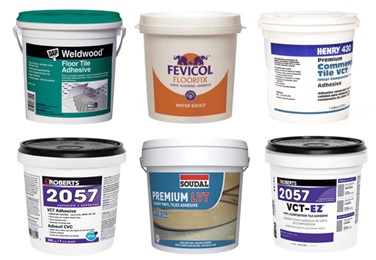
- Peel-and-stick adhesive: Some vinyl tiles come with a self-adhesive backing. You simply peel off the protective paper and stick the tile directly to the floor. This eliminates the need for additional adhesive.
- Pressure-sensitive adhesive: This type of adhesive is commonly used for luxury vinyl tiles (LVT) and luxury vinyl planks (LVP). It is applied to the floor using a trowel or adhesive spreader, and the tiles are then pressed into the adhesive. Pressure-sensitive adhesive remains slightly tacky, allowing for repositioning of tiles during installation.
- Full-spread adhesive: This adhesive is suitable for both vinyl tiles and sheet vinyl. It is applied to the entire surface of the floor using a trowel or adhesive spreader. The tiles are then pressed into the adhesive, ensuring full contact. Full-spread adhesive provides a strong bond but may require longer drying times
Top Vinyl Tile Adhesives Brands In US
While the availability and popularity of specific vinyl tile adhesives may vary depending on location and personal preferences. It is important to check the manufacturer’s instructions and recommendations for the specific vinyl tile adhesive you choose, as different adhesives may have specific usage guidelines and application methods. Additionally, consult with local retailers or professionals for their recommendations based on your specific project requirements.
Here are some popular vinyl tile adhesives in the US:
- Roberts 2057 Premium Vinyl Composition Tile (VCT) Adhesive: This adhesive is specifically formulated for installing vinyl composition tiles. It provides strong bonding and excellent resistance to moisture. It is commonly used for commercial applications.
- Henry 430 ClearPro VCT Vinyl Composition Tile Adhesive: This adhesive is designed for installing vinyl composition tiles and has excellent initial tack and superior bond strength. It is solvent-free and provides a clear and low-odor installation.
- TEC Skill Set Vinyl Composition Tile Adhesive: This adhesive is suitable for installing vinyl composition tiles, luxury vinyl tiles (LVT), and vinyl-backed sheet flooring. It offers high bond strength, quick drying time, and is resistant to moisture.
- Armstrong S-750 Flooring Adhesive: This adhesive is formulated for installing vinyl tiles and sheets. It offers strong initial grab, excellent bond strength, and is moisture-resistant. It is suitable for both residential and commercial applications.
- DAP Weldwood Multi-Purpose Ceramic Tile Adhesive: While primarily designed for ceramic tiles, this adhesive can also be used for vinyl tiles. It offers good adhesion and is easy to use. It is suitable for both wall and floor installations.

